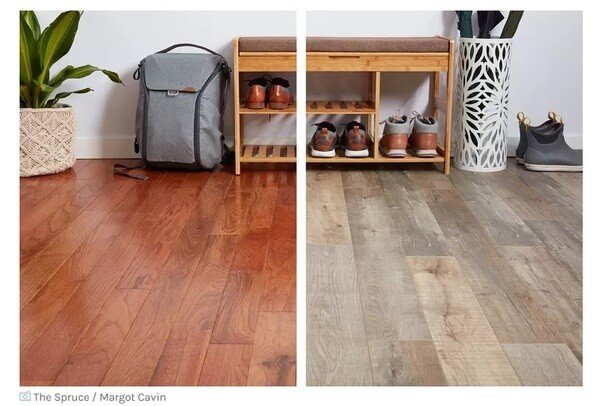Choosing the right flooring for your home is a big decision! It can affect the look, feel, and even the value of your property. Among the top contenders are laminate flooring and wood flooring. While they might seem similar at first glance, these two types of flooring have unique characteristics that make them stand out.
At Kaltimber, we are of course very partial to hardwood flooring, but because we are professionals, we wrote this article with a very fair manner. So lLet’s dive into the delightful differences and help you make an informed and exciting choice for your home renovation or new build project.
Composition
Laminate Flooring:
Laminate flooring is a clever creation made up of several layers. The core layer is usually high-density fiberboard (HDF) or medium-density fiberboard (MDF), providing strength and durability. On top of this core is a photographic layer that beautifully mimics the look of wood, stone, or other materials. The topmost layer is a clear, protective coating that fights off scratches and wears like a champ.
Wood Flooring:
Wood flooring, on the other hand, is the real deal. There are two main types: solid wood and engineered wood. Solid wood flooring consists of single pieces of hardwood, while engineered wood flooring is made of a top layer of hardwood bonded to multiple layers of plywood or other wood products. Both types offer the natural beauty and warmth that only real wood can provide.
Appearance
Laminate Flooring:
Thanks to modern printing technology, laminate flooring can look stunningly like natural wood, stone, or tile. It comes in a dazzling array of styles, colors, and textures, giving you endless design possibilities. However, a close look might reveal that it doesn’t have the same depth and variation as real wood.
Wood Flooring:
Wood flooring is all about that natural beauty and unique charm. Each plank has its own distinct grain pattern, color variation, and texture, which adds to its authenticity. Over time, wood flooring develops a lovely patina, making it even more appealing as it ages gracefully.
Durability and Maintenance
Laminate Flooring:
Laminate flooring is known for its durability and resistance to scratches, dents, and stains. It's perfect for high-traffic areas and homes with pets and children. Plus, it’s easy to maintain—just regular sweeping and occasional mopping with a damp cloth will do the trick. However, laminate flooring doesn’t get along well with water, and prolonged exposure to moisture can cause it to warp or swell.
Wood Flooring:
Wood flooring is generally durable but can be prone to scratches, dents, and wear over time. The great news is that it can be refinished multiple times to restore its original beauty, extending its lifespan. Regular maintenance includes sweeping, vacuuming, and occasional polishing. Just like laminate, wood flooring is sensitive to moisture and humidity, so it needs a bit of extra care in that department.
Installation
Laminate Flooring:
Laminate flooring is a DIY lover’s dream! It often features a click-and-lock system that allows the planks to snap together without the need for nails or glue. You can even install it over most existing floors, like concrete, tile, and vinyl, as long as the subfloor is clean, dry, and level.
Wood Flooring:
Installing wood flooring is a bit more of an adventure and typically requires professional help. Solid wood flooring is usually nailed or stapled to a wooden subfloor, while engineered wood flooring can be glued, nailed, or installed as a floating floor. The process is more time-consuming and labor-intensive compared to laminate, but the results are worth it!
Cost
Laminate Flooring:
Laminate flooring is generally more budget-friendly than wood flooring. Prices can vary depending on the quality and design of the laminate, but it’s typically less expensive than both solid and engineered wood flooring. Plus, the ease of installation can save you some money if you decide to go the DIY route.
Wood Flooring:
Wood flooring, especially solid hardwood, tends to be more of an investment due to the cost of the material and the installation process. Engineered wood flooring is usually more affordable than solid wood but can still be pricier than laminate. The good news is that wood flooring can add significant value to your home, making it a worthwhile investment.
Environmental Impact
Laminate Flooring:
Laminate flooring is made from composite materials and synthetic products, which may include chemicals and adhesives. While some manufacturers are eco-conscious and use green practices, laminate flooring is generally less sustainable than wood flooring. It’s also not biodegradable and can contribute to landfill waste at the end of its life cycle.
Wood Flooring:
Wood flooring is a superstar when it comes to sustainability, especially if you opt for reclaimed wood. Reclaimed wood flooring is recycled from wood that has been salvaged from old buildings, boats, barns, and other structures.
This not only gives the wood a second life but also reduces the demand for new timber. Plus, wood is a renewable resource and can be recycled or repurposed at the end of its life. Look for certifications like Indonesian certification SVLK to ensure the wood comes from sustainable sources.
Conclusion
In a nutshell, the choice between laminate flooring and wood flooring depends on your priorities, budget, and lifestyle. Laminate flooring offers durability, affordability, and easy installation, making it a practical choice for busy households. Wood flooring, with its natural beauty and long-term value, is perfect for those who appreciate the authenticity and charm of real wood. By considering the delightful differences outlined above, you can select the flooring option that best meets your needs and makes your home shine!




